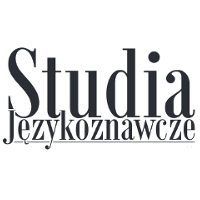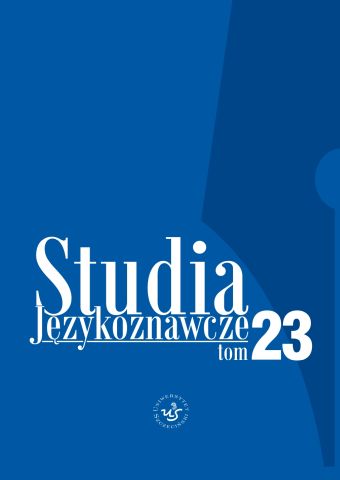





| Authors: |
Anna
Łazuka-Banach

Uniwersytet Szczeciński |
| Keywords: | visual social semiotics power press discourse |
| Whole issue publication date: | 2024 |
| Page range: | 34 (127-160) |
| 1. | Billig Michael. ,,Stacking the cards of ideology: the history of the Sun Souvenir Royal Album”. Discourse & Society, 1(1) (1990), 17–37. |
| 2. | Billig Michael. Ideologies and Beliefs. London: Sage, 1991. |
| 3. | Blommaert Jan. Discourse. Cambridge: Cambridge University Press, 2005. |
| 4. | Coupland Nikolas, Jaworski Adam. ,,Discourse”. W: The Routledge Companion to Se-miotics and Linguistics, red. Paul Cobley. London: Routledge, 2001, 134–48. |
| 5. | Czubiński Antoni. Historia Polski XX Wieku. Poznań: Wydawnictwo Poznańskie, 2003. |
| 6. | EastWest Institute. Available at: https://www.eastwest.ngo/info/about (accessed: 19.09.2023). |
| 7. | El Refaie Elisabeth. ,,Understanding Visual Metaphor: The Example of Newspaper Car-toons”. Visual Communication, 2(1) (2003), 75–95. |
| 8. | El Refaie Elisabeth. ,,Metaphor in Political Cartoons: Exploring Audience Responses”. W: Multimodal Metaphor, red. Charles J. Forceville, Eduardo Urios-Aparisi. Berlin: De Gruyter, 2009, 173–96. |
| 9. | Fairclough Norman. Discourse and Social Change. Cambridge: Polity Press, 1992. |
| 10. | Fowler Roger. Language in the news. Discourse and Ideology in the Press. London: Routledge, 1991. |
| 11. | Gibney Frank B. ‘Nikita Krushchev’, Encyclopaedia Britannica. Available at: https:// www.britannica.com/biography/Nikita-Sergeyevich-Khrushchev (accessed: 19.09.2023). |
| 12. | Giorgi Liana. The Post-Socialist Media: What Power the West? The Changing Media Landscape in Poland, Hungary, and the Czech Republic. Aldershot: Avebury, 1995. |
| 13. | Hodge Bob, Kress Gunther. Social Semiotics. Cambridge: Polity Press, 1988. |
| 14. | Holly Michael Ann. Past Looking: Historical Imagination and the Rhetoric of the Im-age. Ithaca, NY: Cornell University Press, 1996. |
| 15. | Holsanova Jana, Rahm Henrik, Holmqvist Kenneth. ,,Entry Points and Reading Paths on Newspaper Spreads: Comparing a Semiotic Analysis with Eye-Tracking Mesure-ments”. Visual Communication, 5(1) (2006), 65–93. |
| 16. | Jewitt Carey (red.). The Routledge Handbook of Multimodal Analysis. London: Routledge, 2009. |
| 17. | Jewitt Carey, Oyama Rumiko. ,,Visual Meaning: A Social Semiotic Approach”. W: Handbook of Visual Analysis, red. Theo Van Leeuwen, Carey Jewitt. London: Sage, 2001, 134–56. |
| 18. | Kress Gunther, Van Leeuwen Theo. Reading Images. The Grammar of Visual Design. London: Routledge, 1996. |
| 19. | Kress Gunther, Van Leeuwen Theo. ,,Front Pages: (The Critical) Analysis of Newspaper Layout”. W: Approaches to Media Discourse, red. Allan Bell, Peter Garrett. Malden, MA: Blackwell Publishing, 1998, 186-219. |
| 20. | Kress Gunther, Van Leeuwen Theo. Reading Images. The Grammar of Visual Design. London: Routledge, 2006. |
| 21. | Kruk Sergei. ,,Semiotics of Visual Iconicity in Leninist ‘Monumental’ Propaganda”. Visual Communication, 7(1) (2008), 27–56. |
| 22. | Lemke Jay L. Textual Politics. Discourse and Social Dynamics. Wyd. I. Abingdon: Taylor & Francis, 1995. |
| 23. | Lester Paul M. Visual Communication. Images with Messages. Wyd. III. Belmont, CA: Thomson Wadsworth, 2003. |
| 24. | Machin David. ,,Visual Discourses of War. Multimodal Analysis of Photographs of the Iraq Occupation”. W: Discourse, War and Terrorism, red. Adam Hodges, Chad Nilep. Amsterdam/Philadelphia: John Benjamins Publishing Company, 2007a, 123–42. |
| 25. | Machin David. Introduction to Multimodal Analysis. London: Hodder Arnold, 2007b. |
| 26. | Nickel Douglas R. ,,Impressed by nature’s hand’: photography and authorship”. W: Us-ing Visual Evidence, red. Richard Howells, Robert W. Matson. Maidenhead, Berkshire: Open University Press, 2009, 43–54. |
| 27. | Pinar Sanz Maria J. ,,Decoding Meaning in Political Cartoons”. W: From Language to Multimodality. New Developments in the Study of Ideational Meaning, red. Carys Jones, Eija Ventola. London Oakville: Equinox Publishing, 2008, 313–34. |
| 28. | Rose Gillian. Visual Methodologies: An Introduction to the Interpretation of Visual Materials. London: Sage, 2007. |
| 29. | Scollon Ron, Scollon Suzie W. Discourses in Place. London: Routledge, 2003. |
| 30. | Van Dijk Teun A. Ideology: A Multidisciplinary Approach. London: Sage, 1998. |
| 31. | Van Leeuwen Theo. ,,Semiotics and Iconography”. W: Handbook of Visual Analysis, red. Theo Van Leeuwen, Carey Jewitt. London: Sage, 2001, 92–118. |
| 32. | Van Leeuwen Theo. Introducing Social Semiotics. London: Routledge, 2005. |
| 33. | Van Leeuwen Theo. Discourse and Practice: New Tools for Critical Discourse Analysis. Oxford: Oxford University Press, 2008. |
| 34. | Ventola Eija. ,,Semiotic Spanning at Conferences; Cohesion and Coherence in and across Conference Papers and Their Discussions”. W: Coherence in Spoken and Written Discourse. How to Create It and How to Transcribe It, red. Wolfram Bublitz et al. Ams-terdam/Philadelphia: John Benjamins, 1999, 101–25. |